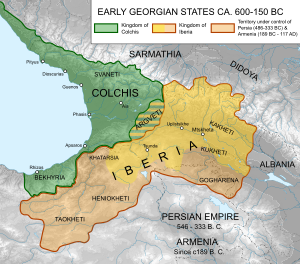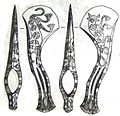|
Colchian culture
 Colchian culture (Georgian: კოლხური კულტურა; 2700 BCE to 700 BCE)[1] is Neolithic, early Bronze Age and Iron Age culture of the western Caucasus, mostly in western Georgia. Colchian culture was divided into two periods: Proto-Colchian (2700–1600 BC) and Ancient Colchian (1600–700 BC). It was partially succeeded by the Koban culture in Northern Caucasus and Colchian influence also spread in Shida Kartli, Meskheti, North-Eastern Anatolia.[2] According to the professor of archaeologist Antonio Sagona:
It is named after the ancient geographic region of Colchis, which covered a large area along the Black Sea coast. It is mainly known for highly developed bronze production and artistic craftsmanship.[4] There are many items of copper and bronze found in ancient graves. Graves found and studied have been located in the Abkhazia region,[5] the Sukhumi mountain complexes,[6] the Racha highlands where brick tiles and graffiti have been found, and the Colchian plains (კოლხეთის დაბლობი) where collective graves have been found. Collective graves occurred during the last stages of the Colchian culture (c.8th century to 6th century BCE). In these graves bronze items were found that represented foreign trade occurred with the Colchian culture. At this time an increase in the production of weapons and agricultural tools is seen. Evidence of copper mining has been found in Racha, Abkhazia, Svaneti, and Adjara.[4][6] Ruins of palaces are present in the Colchian Plains.[7] Colchian culture is characterized by Colchian axes, sickles, short spears, flat axes, bow-shaped and cylindrical axes, belts, bracelets, bearings, and statuettes. The items are often painted and sometimes even with the sculptural expression expressing the religious ideas of the Colchis. Colchians are the ancestors of the modern day western Georgians, most notably Zans/Chans (ჭანები) - Megrelians and the Laz people, as well as Svans of the northern region of Svaneti in Georgia.
See alsoReferences
External links
|






